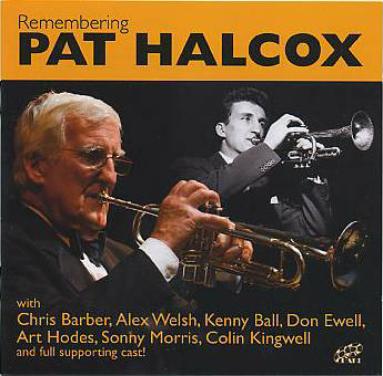CD Review
Bert Thompson
Disc One: Mr. Halcox & Mr. Barber – playing time 79m. 37s.
1950s: New Orleans Hop Scop Blues; Who’s Sorry Now?; I Love My Baby; Old Stackolee
1960s: Blue Turning Grey over You; The Mountains of Mourne; Do Right Baby; Shine
1970s: Georgia on My Mind; Rent Party Blues; Somewhere over the Rainbow
1980s: Buddy Bolden’s Blues; Some of These Days; Blues on Trumpet; Oh Baby
1990s: Working Man Blues; Isle of Capri.
Recorded between 1955 and 1998, no locations given.
Disc Two: Pat Plays Away – playing time 75m. 47s.
Give Me Your Telephone Number; Wabash Blues; Rosetta; Confessin’; Tin Roof Blues; I
Found a New Baby; Undecided; Blues for Humph; Blue Orchid; Apple Honey; I Let a
Song Go Out of My Heart.
Recorded between 1964 and 1996, no locations given.
Personnel: All tracks include Pat Halcox on cornet, trumpet, or flugelhorn. Others, too
many to list in full, include Chris Barber, Monty Sunshine, Wally Fawkes, Sonny Morris,
Art Hodes, Don Ewell, Alex Welsh, Kenny Ball, and Ottilie Patterson. All data are given
in the CD booklet.
Jazz has had several memorable musical partnerships, including those of
Oliver/Armstrong, Armstrong/Teagarden, Ellington/Strayhorn, Brubeck/Desmond,
Lyttelton/Fawkes among others, that engendered some exquisite music. Few, if any,
however, have outlasted the fifty-odd years of the Pat Halcox/Chris Barber
collaboration. This set is not so much a celebration of that alliance as it is a showcase for
the talents of Mr. Halcox, so there is not much of the two of them playing together on
these discs, despite the title of the first, “Mr. Halcox & Mr. Barber.”
The first of these two discs presents selections from the first five decades of the Barber
band—there are none from the 2000s prior to Halcox’s retirement in 2008 from full time
playing with the band due to health issues from Parkinson’s disease, although he did not
give up playing entirely at that time. Only five of these selections include both Barber
and Halcox, the others being various combinations of personnel from the Barber band,
all supporting Halcox. None of these tracks has been previously issued.
In the Chris Barber band of 1953, Halcox had played cornet but was reluctant to “go pro”
when the others did, being replaced by Ken Colyer, who had just returned to some
acclaim from a visit to New Orleans where he played with some of the pioneers of the
revival, ending with a stint in the New Orleans jail for overstaying his visa. A year or so
later, as most people know, the band left Colyer, and Halcox, now prepared to take the
professional plunge, rejoined. The first cut, a hard driving New Orleans Hop Scop
Blues, is from the next year, 1955, and is a tune seldom played by traditional jazz bands.
On it Halcox plays cornet in a tight front line, as he did for the first year or two before
switching to trumpet, and he displays some of the fairly broad vibrato that was part of
his technique at that time. With his change to trumpet, the vibrato diminished
somewhat, as we hear on the second number, Who’s Sorry Now? which, apart from the
coda, is largely a solo vehicle for Halcox, accompanied only by the rhythm section. He is
equally adept with slower tempos, of course. I have never heard Working Man Blues
played this slowly—but it comes off, and I like to think Messrs. Oliver and Armstrong
would have approved.
|
|







